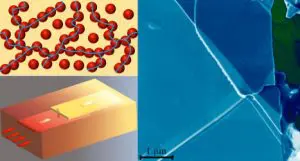It is well known that incorporating graphene fillers to the base (matrix) of a composite thermal interface material (TIM) can improve the resulting thermal conductivity of the composite. In fact, the intrinsic thermal conductivity of large graphene layers exceeds that of the high-quality bulk graphite, which itself is very high: 2000 W m−1 K−1 . But most of the studies of thermal composites with graphene have been limited to the relatively low loading fractions, f ≤ 10 vol %.
In a recent paper published in ACS Applied Materials and Interfaces (“Thermal percolation threshold and thermal properties of composites with high loading of graphene and boron nitride fillers”), a research team led by Dr. Alexander Balandin, Distinguished Professor at the Department of Electrical and Computer Engineering, University of California, Riverside (UCR) found that composites made from epoxy resin containing graphene could be used to dissipate excess heat from electronic devices. In particular the researchers looked at graphene composites with a high loading fraction—up to f ≈ 45 vol %—of randomly oriented electrically conductive graphene fillers and that of another highly thermally conductive material, boron nitride fillers. The graphene fillers outperformed the boron nitride fillers in terms of thermal conductivity enhancement.
Both types of the composites revealed a distinctive thermal percolation threshold at the loading fraction fT > 20 vol %. “Percolation” relates to a theory of why something happens, in this case a critical concentration at which by adding a little bit more of conductive filler suddenly makes the thermal conductivity increase by an order of magnitude or more.
The randomly oriented graphene fillers can deliver thermal conductivity values of above 12 W/mK. In contrast commercially available TIMs generally offer thermal conductivity in the range of 0.5 W/mK to 5 W/mK.
Figure 1 Top left: Optical image of the pristine epoxy, and epoxy with the loading of 18 vol % and 19 vol % of graphene and h-BN fillers, respectively. Bottom left: Schematic of the composite with the low (left) and high (right) volume fraction of fillers. Right: Scanning electron microscopy image of the epoxy composite with 45 vol % of graphene fillers. (Source: Baladin Group, University of California Riverside)
An earlier experimental study of the thermal conductivity of single-layer graphene, conducted in 2008 (“Extremely High Thermal Conductivity of Graphene: Prospects for Thermal Management Applications” in Nanoelectronic Circuits, Applied Physics Letters 92(15):151911-151911-3 · April 2008), found that on top of its many unique electronic properties, graphene is an extraordinarily good heat conductor. Measurements revealed that graphene’s room temperature thermal conductivity, which is in the range from 3500–5300 W/mK, is much higher than that of the best bulk crystal heat conductor, diamond.
The UCR researchers further found that the graphene loading required for achieving thermal percolation, fT, was substantially higher than the loading, fE, for electrical percolation. In fact they determined that graphene composites reach a distinctive thermal percolation threshold at the loading fraction above 20 vol %
Other members of the research team included Dr. Fariborz Kargar, postdoctoral researcher and the first author of the study, and doctoral students Zahra Barani, Ruben Salgado, Bishwajit Debnath, Jacob S. Lewis, and Ece Aytan. Dr. Roger Lake, Professor at the Department of Electrical and Computer Engineering assisted with the numerical modeling of the composites.
The team concluded: “The surprising finding is that, in the high loading composites with quasi-2D fillers, the apparent cross-plane thermal conductivity of the fillers can be the limiting factor for heat conduction.” They characterized the obtained results as “important for developing the next generation of the thermal interface materials.”






